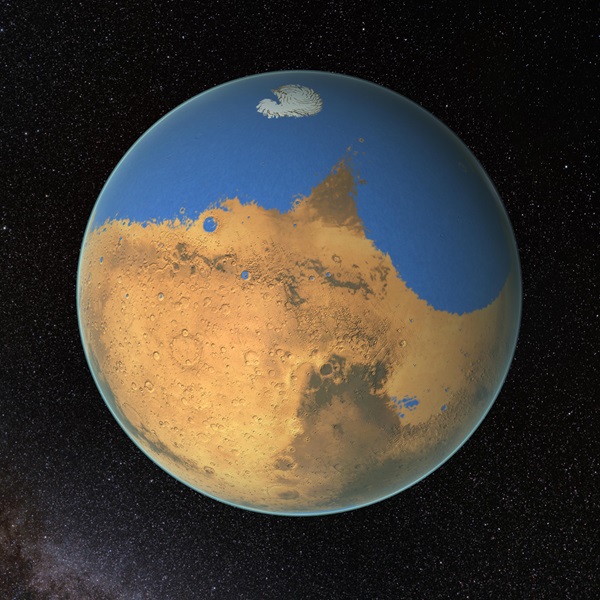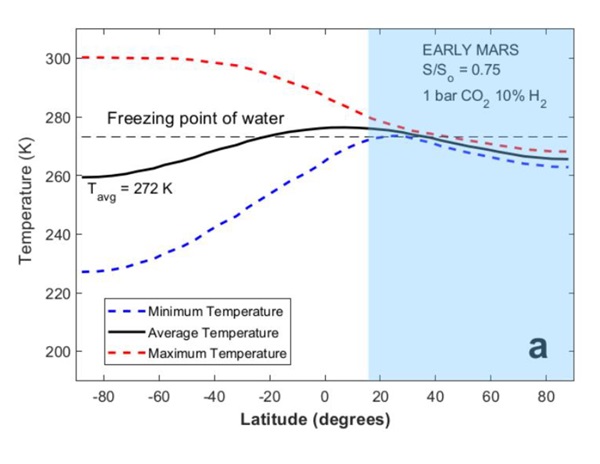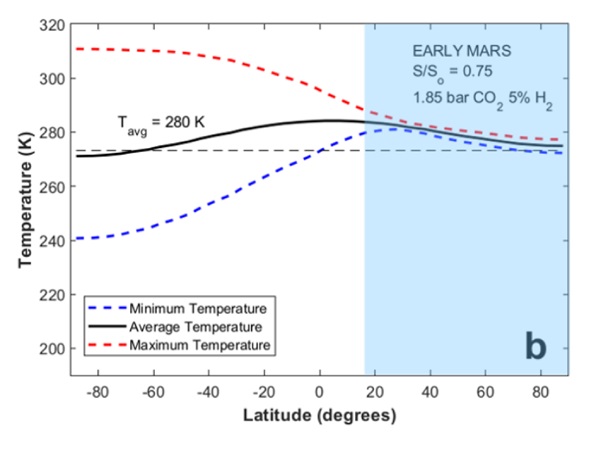This is the first model to demonstrate that a relatively large northern ocean, and a sustained hydrologic cycle, were necessary to form the observed surface fluvial features on early Mars. Icy climates cannot produce the water required to explain the geologic evidence. These results support a warm and semi-arid climate consistent with many geologic observations.

Today Mars is a dry and cold planet that looks quite ’Moon-like’. However, ancient landscapes on Mars depict a world that may have been much more Earth-like billions of years ago. The surface is filled with ancient riverbeds, deltas, heavily modified craters, and even features that look a lot like ancient ocean shorelines. Some scientists think that such fluvial features suggest a warmer and wetter early planet, whereas others believe that these features likely formed when the planet was as cold and dry as it is today.
’This is an important question because if Mars was warmer and wetter in the past, conditions may have been suitable for the emergence of life’, says Ramses Ramirez, a research scientist at the Earth-Life Science Institute.
The team, consisting of Ramses, Bob Craddock (Smithsonian Institution), and Tomohiro Usui (JAXA/ISAS and Earth-Life Science Institute) explored the idea that a warm early Mars could have had a large northern ocean (Figure 1).
The topography on early Mars is unknown. This would have determined where precipitation could have fallen and whether it would have taken the form of rain or snow. Most studies have assumed that the past topography was similar to today’s, which would have produced large ice accumulations at high elevations. This scenario motivated many subsequent early Mars was cold and icy hypotheses. However, both orbital observations and rover data have convincingly shown it is likely Mars did not have a very icy early climate. Revised geologic mapping also suggests a flatter early Mars, one where the volcanoes were forming at the same time that the valley networks and other fluvial features were. This implies that volcanism was likely producing high enough concentrations of greenhouse gases (like CO2 and H2) to warm the climate and produce rain (Figure 2).
Assuming a flatter topography, plus a northern hemispheric ocean (Figure 1), the team showed that enough rain would have produced the observed surface geology if mean surface temperatures were between ~270 – 280 K. Temperatures colder than these would freeze the ocean and shut down the hydrologic cycle. At still higher temperatures, the model predicts more surface erosion that what is observed.
Some have argued that a warm and wet climate would have left behind thick glaciers following the end of the warm period, but supporting geologic evidence is not observed. Instead, the team’s work supports an arid to semi-arid early Martian climate that was wet enough to rain, but not humid enough to leave behind thick glaciers following the warm period. Such a climate could have potentially formed all of the surface features in a relatively brief warm episode lasting between a few hundred thousand to 10 million years. Bob Craddock stated, ’This is the first detailed model to reconcile the entire suite of fluvial geologic features with the climatic conditions that were present early in Martian history.’


| Journal | Journal of Geophysical Research: Planets |
| Title of the paper | Climate of early Mars with estimated precipitation, runoff, and erosion rates |
| Authors | Ramses M. Ramirez1,2, Robert A. Craddock3, Tomohiro Usui1,4 |
| Affiliations | 1Earth-Life Science Institute, Tokyo Institute of Technology, Tokyo, Japan 2Space Science Institute, Boulder, Co, USA 3Center for Earth and Planetary Studies, National Air and Space Museum, Smithsonian Institution, Washington D.C., USA 4Institute of Space and Astronautical Science (ISAS), Japan Aerospace Agency, Tokyo, Japan |
| DOI | 10.1029/2019JE006160 |
| Online published date | March 10, 2020 |
